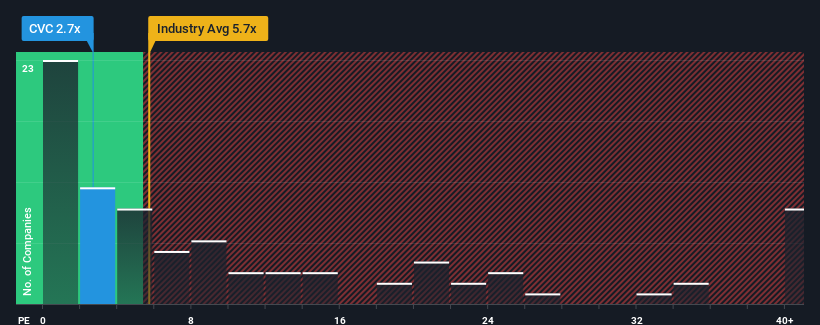You may think that with a price-to-sales (or "P/S") ratio of 2.7x CVC Limited (ASX:CVC) is definitely a stock worth checking out, seeing as almost half of all the Capital Markets companies in Australia have P/S ratios greater than 5.7x and even P/S above 16x aren't out of the ordinary. However, the P/S might be quite low for a reason and it requires further investigation to determine if it's justified.
View our latest analysis for CVC

What Does CVC's P/S Mean For Shareholders?
With revenue growth that's exceedingly strong of late, CVC has been doing very well. It might be that many expect the strong revenue performance to degrade substantially, which has repressed the P/S ratio. If that doesn't eventuate, then existing shareholders have reason to be quite optimistic about the future direction of the share price.
Want the full picture on earnings, revenue and cash flow for the company? Then our free report on CVC will help you shine a light on its historical performance.How Is CVC's Revenue Growth Trending?
There's an inherent assumption that a company should far underperform the industry for P/S ratios like CVC's to be considered reasonable.
Taking a look back first, we see that the company grew revenue by an impressive 32% last year. The latest three year period has also seen an excellent 75% overall rise in revenue, aided by its short-term performance. Therefore, it's fair to say the revenue growth recently has been superb for the company.
This is in contrast to the rest of the industry, which is expected to grow by 4.1% over the next year, materially lower than the company's recent medium-term annualised growth rates.
With this information, we find it odd that CVC is trading at a P/S lower than the industry. It looks like most investors are not convinced the company can maintain its recent growth rates.
The Key Takeaway
Generally, our preference is to limit the use of the price-to-sales ratio to establishing what the market thinks about the overall health of a company.
Our examination of CVC revealed its three-year revenue trends aren't boosting its P/S anywhere near as much as we would have predicted, given they look better than current industry expectations. When we see strong revenue with faster-than-industry growth, we assume there are some significant underlying risks to the company's ability to make money which is applying downwards pressure on the P/S ratio. While recent revenue trends over the past medium-term suggest that the risk of a price decline is low, investors appear to perceive a likelihood of revenue fluctuations in the future.
We don't want to rain on the parade too much, but we did also find 3 warning signs for CVC that you need to be mindful of.
Of course, profitable companies with a history of great earnings growth are generally safer bets. So you may wish to see this free collection of other companies that have reasonable P/E ratios and have grown earnings strongly.
New: AI Stock Screener & Alerts
Our new AI Stock Screener scans the market every day to uncover opportunities.
• Dividend Powerhouses (3%+ Yield)
• Undervalued Small Caps with Insider Buying
• High growth Tech and AI Companies
Or build your own from over 50 metrics.
Have feedback on this article? Concerned about the content? Get in touch with us directly. Alternatively, email editorial-team (at) simplywallst.com.
This article by Simply Wall St is general in nature. We provide commentary based on historical data and analyst forecasts only using an unbiased methodology and our articles are not intended to be financial advice. It does not constitute a recommendation to buy or sell any stock, and does not take account of your objectives, or your financial situation. We aim to bring you long-term focused analysis driven by fundamental data. Note that our analysis may not factor in the latest price-sensitive company announcements or qualitative material. Simply Wall St has no position in any stocks mentioned.
About ASX:CVC
CVC
A venture capital and private equity firm specializing in, management buy-outs, seed/startup, early venture, mid venture, late venture, emerging growth, mezzanine, and growth capital investments.
Low risk with questionable track record.
Similar Companies
Market Insights
Community Narratives



